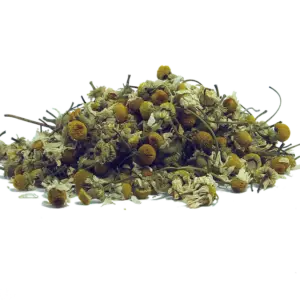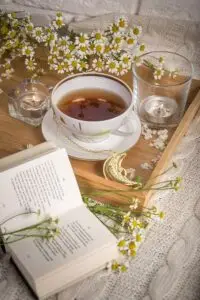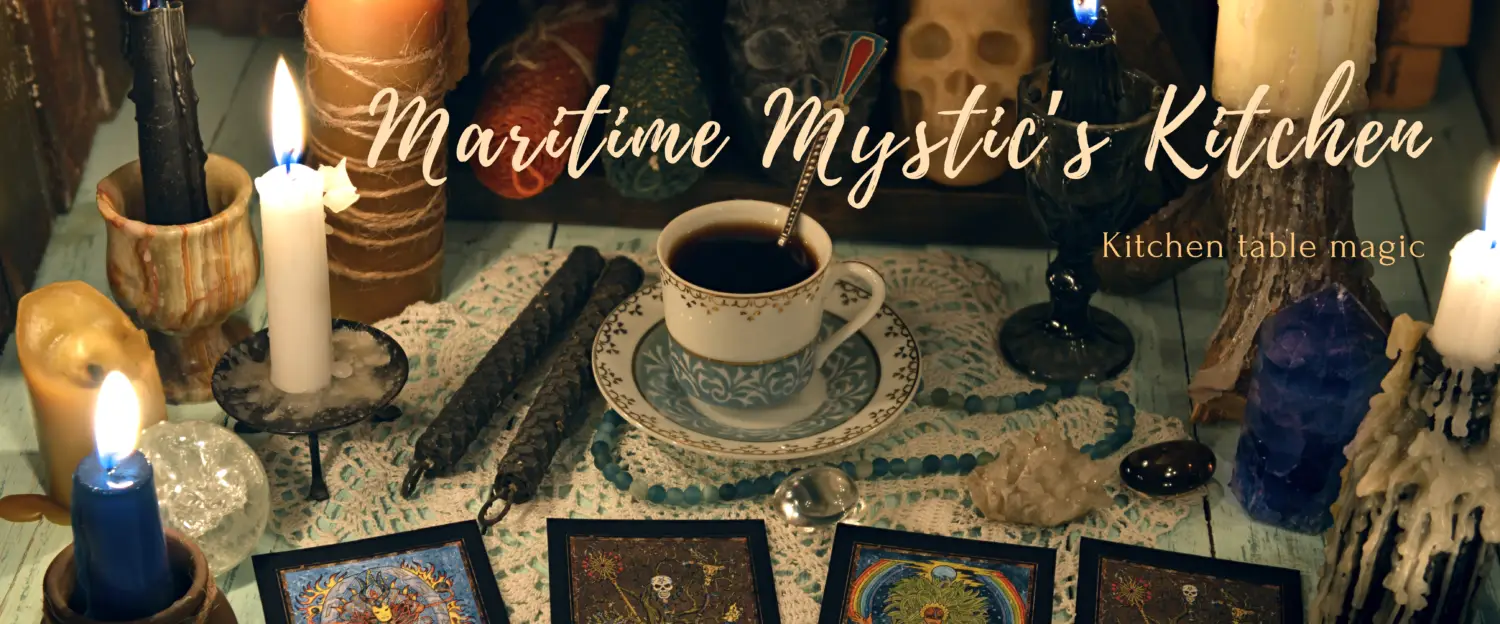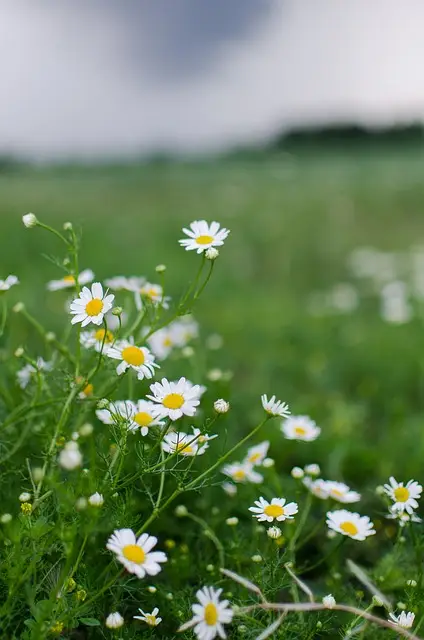Well, there are actually four chamomiles that I know of, not one. I have three of them in my collection: Roman, Cape, and Wild Chamomile. I have not added German Chamomile essential oil to my aromatherapy dispensary yet, but one of these days I will get around to it. All of the chamomiles are similar, but each is different. Today, I’ll profile the ones I have and discuss them. Before we get any further, no, I am not a Young Living or DoTerra person. Do I have some of their products? Yes. I have been gifted several essential oils produced by these companies but this is an MLM-free space so I don’t promote those brands here. They are no better or worse than any other brand. Who DO I purchase from?
- Miracle Botanicals This is a Hawaiian small business run by a family. They distill some of their products and source others ethically. I have been purchasing from them for years and their products never fail to disappoint.
- Original Swiss Aromatics This company is located in San Rafael, California, and was founded in 1983 by Dr. Kurt Schnaubelt. He is the author of some of the best aromatherapy books on the market, including Medical Aromatherapy and Advanced Aromatherapy.
General properties of Chamomile
- analgesic (pain-relieving)
- antidepressant (helps with depression and anxiety)
- anti-inflammatory (counteracts inflammation)
- antiphlogistic (reduces existing inflammation)
- antispasmodic (prevents or treats muscle spasms)
- carminative (relieves flatulence)
- diuretic (promotes the flow of urine)
- hepatic (relating to the liver)
- nervine (soothes nervous excitement)
- sedative (promotes sleep and relaxation)
- stomachic (improves appetite)
Using Chamomile
I suggest using chamomile essential oil in small amounts. Aromatherapy works best using the smallest dose possible. As far as essential oil goes, chamomile is quite strong both in scent and action. A little goes a long way and it will very quickly dominate your blends if you add too much. One of the reasons that chamomile costs what it does is the amount of flowers that go into its creation so bear that in mind – a lot of flower power is in this essential oil and florals tend to be the strongest smelling.
My favorite way to use almost every essential oil in my dispensary is through foot massage. Back in the early 90s, I went to an herbalism seminar in Halifax. The herbalist who was talking brought people up from the audience to soak their feet in a warm footbath containing gauze bags full of specific herbs. When she concluded her introduction about 20 minutes later we were invited to file across the stage and smell the breath of our volunteers. Every one of them exhaled the scent of the herb because it was absorbed through their feet, in the water. This has stayed with me and as an aromatherapist, I apply treatments this way, through the direct application of essential oils, diluted so as not to irritate the skin. I don’t typically put them in foot baths because the essential oil compounds are volatile and will evaporate quickly.

During the 2020 lockdowns in Canada, my sleep patterns were greatly disrupted. I mixed two drops of Roman Chamomile into some lotion nightly and massaged my feet with the mixture. I would drift off to sleep and stay that way until 7 am when I woke up refreshed. I have heard people say that putting a drop on the pillow is effective as well. I have tried this and do not recommend it simply because the smell can be overwhelming to some people.
Direct inhalation methods – like placing a drop or two on a cotton pad or tissue – can be effective but should only be used in short bursts of up to five minutes at a time. If you choose to use a diffuser, only diffuse a few drops for 15 minutes, and be mindful of small children or animals in the environment because atomized essential oil particles can leave a film that can eventually build up on floors, walls, furniture, and other items in the room. 
Both pets and children put things in their mouths and pets groom themselves with their tongues, so they can potentially ingest damaging quantities of essential oils. I know there are pet-safe and child-safe essential oils but here on my blog, I don’t advise exposing them to aromatherapy products because people take what you say and then go off and do Stupid Human Tricks later.
As an esthetician, I look for chamomile-infused products for treating sensitive, reactive, and inflamed skin. Masks and hydrosols are wonderful ways to experience the effects of this flower without breaking the bank. After an intense facial treatment, I will often add a drop of chamomile essential oil to a rich cream mask or leave-on moisturizer to help calm ruddy skin. A drop added to the contents of a capsule or two of Evening Primrose Oil makes a fabulous nighttime skin treatment.
So why do I have three varieties? Well, they each have their strengths and I will list them here:
- Roman Chamomile is my all-purpose chamomile essential oil. When in doubt, get this one chamomile and you’ll be fine. It has all the properties listed at the beginning of this post and works well for a large cross-section of people. It has a rich, full, warm fruity-floral smell that is quite strong. I like it, but as I said before, it can dominate a dominate a blend. Less is best.
- Cape Chamomile is a newer addition to aromatherapy. It has compounds that make it exceptional in the treatment of emotional issues, particularly anxiety and panic attacks. It’s also excellent at repairing damaged nerve tissue. Last year my wife damned near degloved her fingers in a workplace accident. If you don’t know what degloving is, do not look it up or you won’t be able to unsee it. Suffice it to say that a year later she goes for physical therapy to help treat her hand. A regular, nightly application of this oil has helped her to regain some sensitivity. The smell of Cape Chamomile essential oil is deeper and…..earthier….yes, we’ll say earthier, than my other chamomiles. It’s like chamomile with a slight patchouli undertone. I feel like that’s an acquired smell.
- Wild Chamomile used to be referred to as Ormenis Flower in my old aromatherapy textbooks from the 70s and 80s. It’s got that same apple-floral smell but it’s crisper and more upbeat. There are grassy notes and I swear to you I can smell sunshine when I inhale the oil. It’s a great oil for raising energy in a room. You know that feeling, you may not consider yourself particularly psychic but you can tell when you’ve walked into a room where words have just been exchanged. Even if everyone is behaving normally, you can still tell. Using this oil as a room spray or in a diffuser for a few minutes helps to clear out energetic crapulence. It also seems to have a wonderfully sedative effect on people when they can’t wind down. I am finding that if Roman Chamomile won’t help them, this one will.

